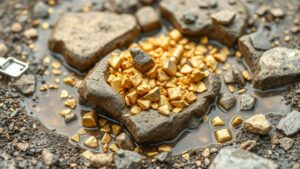How to Analyze Stream Energy Levels to Pinpoint Gold Concentration
How to Analyze Stream Energy Levels to Pinpoint Gold Concentration
The pursuit of gold has fascinated humanity for centuries, driving exploration and mining endeavors. By understanding stream energy levels, prospectors can enhance their ability to locate gold deposits within a waterway. This article delves into the analysis of stream energy levels, focusing on how these dynamics influence gold concentration and providing practical techniques for prospectors.
Understanding Stream Energy Levels
Stream energy levels refer to the kinetic energy contained within flowing water. This energy is affected by various factors such as water volume, velocity, gradient, and channel shape. Gold, being a dense mineral, behaves differently when subjected to various energy levels in a stream.
The Role of Stream Energy in Gold Transport
Stream velocity plays a critical role in determining where gold particles will settle. In areas with high energy, gold may remain suspended due to the force of the water, whereas in low-energy zones, heavier particles, such as gold, will start to accumulate. equation for stream energy, expressed as:
E = 0.5 × m × v²
illustrates that energy increases with the square of the velocity, meaning that small changes in speed can lead to significant increases in energy. So, understanding where the energy diminishes is crucial for prospectors.
Mapping Stream Energy Levels
Analyzing stream energy requires a methodical approach to mapping and evaluating various stream attributes:
- Velocity Measurement: Use a flow meter to measure water speed across different stream sections. High-velocity areas (typically >1.5 m/s) indicate potential gold transport zones.
- Gradient Calculation: Calculate stream gradient by measuring elevation changes over a distance. Steeper gradients usually correlate with higher energy levels.
- Channel Shape Analysis: Analyze the cross-sectional shape of the stream. Wide, shallow areas may slow water down and allow gold deposition.
By creating a detailed map of these factors, prospectors can identify locations for potential gold accumulation.
Identifying Gold Deposition Zones
Once stream energy levels are mapped, the next step is to pinpoint deposition zones. Key indicators include:
- Inside Bends: Water slows on the inside of bends, allowing for sediment and gold to settle.
- Drop-offs or Pools: Areas where the stream depth increases can trap heavier materials as water velocity decreases.
- Wake Areas: Behind boulders or other obstructions, where vortices form and reduce energy, creating zones where gold might accumulate.
Case Studies and Real-World Examples
Case studies provide valuable insights into the practical application of energy level analysis. For example, in the Sierra Nevada foothills, early prospectors utilized these principles to locate gold in streams. By concentrating their efforts on low-energy zones downstream of steep gradients and in areas with significant channel obstructions, they significantly increased their gold yields.
Tools and Techniques for Prospectors
Several tools can aid in accurately analyzing stream energy and enhancing gold prospecting efforts:
- Flow Meters: For precise measurement of stream velocity at various points.
- GPS Devices: To map and revisit potential gold deposition sites accurately.
- Mapping Software: To create detailed topographical maps that highlight energy gradients and deposition zones.
Actionable Takeaways
To effectively analyze stream energy levels for gold exploration, prospectors should:
- Conduct thorough velocity measurements across different stream sections.
- Map gradients and assess channel shapes to identify potential gold deposition zones.
- Use appropriate tools to aid in analysis and improve the chances of locating gold.
To wrap up, understanding the relationship between stream energy levels and gold concentration is vital for successful prospecting. By employing analytical methods and tools, prospectors can enhance their exploration strategies and increase their likelihood of discovering gold deposits in streams.


